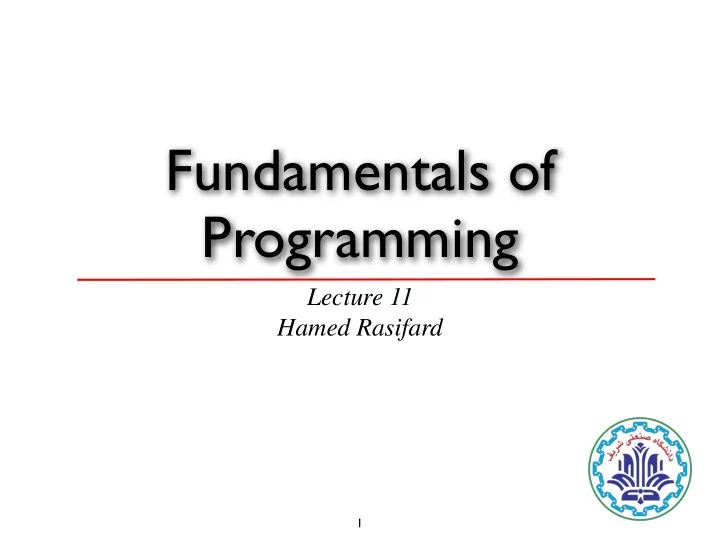

Fundamentals of Programming Lecture 11 Hamed Rasifard 1
Outline • Enumerations • C++ 2
Enumerations • An enumeration is a set of named integer constants. • Enumerations are defined much like structures; the keyword enum signals the start of an enumeration type. • The general form for enumerations is: enum tag { enumeration list }; 3
Using Enumeration Type #include <stdio.h> enum coin { penny, nickel, dime, quarter, half_dollar, dollar}; int main( void ) { enum coin money; money = dime; switch(money) { case penny: printf("penny"); break; case nickel: printf("nickel"); break; case dime: printf("dime"); break; case quarter: printf("quarter"); break; case half_dollar: printf(''half_dollar"); break; case dollar: printf("dollar"); } return 0; 4 }
C++ • C++ began as an expanded version of C. • C++ improves on many of C’s features and provides object-oriented-programming (OOP) capabilities that increase software productivity, quality and reusability. This chapter dis- cusses many of C++’s enhancements to C. 5
Object-oriented Programming • a program can be organized in one of two ways: around its code (what is happening) around its data (who is being affected) • Using only structured programming techniques, programs are typically organized around code. • Object-oriented programs organized around data, with the key principle being "data controlling access to code." 6
A Sample C++ Program #include <iostream> using namespace std; int main() { int i; cout << "This is output.\n"; // this is a single line comment /* you can still use C style comments */ // input a number using >> cout << "Enter a number: "; cin >> i; // now, output a number using << cout << i << " squared is " << i*i << "\n"; return 0; } 7
C++ Standard Library • C++ programs consist of pieces called classes and functions. • most C++ programmers take advantage of the rich collections of existing classes and functions in the C++ Standard Library. • You should learn how to use the classes and functions in the C++ Standard Library. 8
Header File • The C++ Standard Library is divided into many portions, each with its own header file. • The header files contain the function prototypes for the related functions that form each portion of the library. • A header file “instructs” the compiler on how to interface with library and user- written components. 9
Namespaces • A namespace is simply a declarative region. • The purpose of a namespace is to localize the names of identifiers to avoid name collisions. • Elements declared in one namespace are separate from elements declared in another. • When you include a new-style header in your program, the contents of that header are contained in the std namespace. 10
C++Classes • A class is a user-defined type. • A class is similar syntactically to a structure. • Classes consist of data members and member functions 11
A class declaration class class-name { private data and functions access-specifier: data and functions access-specifier: data and functions // ... access-specifier: data and functions } object-list; 12
Access Control • There are three kinds of access specifier to data in classes Private Public Protected • Data are private in a class by default 13
A Simple Class #define SIZE 100 // This creates the class stack. class stack { int stck[SIZE]; int tos; public: void init(); void push(int i); int pop(); }; void stack::init() { //Code goes here } void stack::push(int i) { //Code goes here } int stack::pop() { //Code goes here } 14
Scope Resolution Operator • In C++, several different classes can use the same function name. • The :: is called the scope resolution operator. • The compiler knows which function belongs to which class because of the scope resolution operator. 15
Using Classes #include <iostream> using namespace std; #define SIZE 100 // This creates the class stack. class stack { . . . }; . . . int main() { stack stack1, stack2; // create two stack objects stack1.init(); stack2.init(); stack1.push(1); stack2.push(2); stack1.push(3); stack2.push(4); cout << stack1.pop() << " "; cout << stack1.pop() << " "; cout << stack2.pop() << " "; cout << stack2.pop() << "\n"; return 0; 16 }
Constructors • The use of functions such as init() to provide initialization for class objects is inelegant and error- prone. • A better approach is to allow the programmer to declare a function with the explicit purpose of initializing objects. • Because such a function constructs values of a given type, it is called a constructor. • A constructor is recognized by having the same name as the class itself. 17
Constructors(Cont.) • When a class has a constructor, all objects of that class will be initialized. • If the constructor requires arguments, these arguments must be supplied class Date{ int y, m, d; public: //... Date(int, int, int); // day, month, year Date(int, int); // day, month, today’s year Date(int); // day today’s month and year Date(); // default Date: today Date(const char*); // date in string representation }; 18
Recommend
More recommend